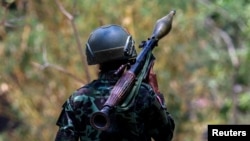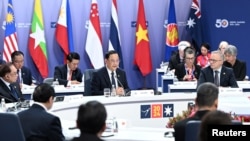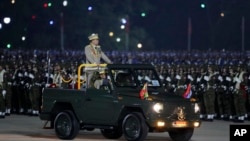ASEAN has been viewed by the international community as the ideal political bloc to negotiate a resolution to the conflict that has beset Myanmar since its military, led by Gen. Min Aung Hlaing, ousted an elected government in early 2021 and sparked a civil war.
But the five-point consensus on ending the Myanmar crisis put forward by ASEAN — the Association of Southeast Asian Nations — has been discredited by analysts and anti-regime forces who argue the 10-nation bloc has quietly backed the junta and ignored all other parties in the conflict.
“The five-point consensus has been a dismal failure,” said Ross Milosevic, a risk consultant who conducts field research in Myanmar. But he added, recent unprecedented battlefield defeats of the military — also known as Tatmadaw — and elections within ASEAN members were rewriting the political equation.
The five point-consensus is a roadmap for peace insisted upon by ASEAN, calling for an immediate end to violence; dialogue among all parties; the appointment of a special envoy; humanitarian assistance by ASEAN; and the special envoy’s visit to Myanmar to meet with all parties.
The turning point
After a bitter, five-month dry season offensive, ethnic armed organizations (EAOs) and the opposition-led National Unity Government’s People’s Defence Force (PDF) are in control of nearly all ethnic territories and states and Myanmar’s borders with Thailand, Laos, China, India and Bangladesh.
Despite ongoing military aerial bombardments, the ethnic Karen in the southeast along the Thai border and the Shan, which share a border with China in Myanmar’s north, are asserting political control, and Milosevic said the Mon, Kachin and Arakan are following.
That leaves Tatmadaw encircled but heavily fortified within central Barma state and in control of the all-important corridors linking Yangon, Naypyidaw and Mandalay.
“Those battlefield successes have not only spooked the Tatmadaw generals but also many within ASEAN’s political leadership,” Milosevic said, adding the junta’s greatest loss was Myawaddy, a border trading hub which sits adjacent to Mae Sot in Thailand.
“It remains to be seen whether the civil war will continue till the end of the year, it may even fall sooner than expected,” he said. “I hope that Thailand will lead the charge in trying to put forth a real solution to the fighting, death and destruction that’s been caused in the last three years.”
Among the 50 wars tracked globally by the Armed Conflict Location and Event Data Project, Myanmar is considered the most violent with at least 50,000 people killed since the coup, including 8,000 civilians.
Reshaping ASEAN politics
ASEAN has been divided between democratically elected governments and autocratic one-party states, with countries like Cambodia and current chair Laos accused of blocking policies over a range of issues, including Myanmar, out of their own interests.
Charles Santiago, from ASEAN Parliamentarians for Human Rights, has consistently criticized the bloc and individual members for being too soft on the junta while ignoring the plight of their victims.
“ASEAN has to get a backbone and be guided by a clear policy. Given Laos’ leadership, I don’t think it’s going to happen. Laos hasn’t shown, not even mentioned, what they’re doing and ASEAN hasn’t said what their plans are,” he said.
Shortly before Myawaddy fell to the Karen National Liberation Army on April 10 — one of about 20 EAOs battling Tatmadaw alongside the PDF — former Cambodian prime minister Hun Sen offered to open talks with Hlaing, now chairman of the State Administration Council, “aimed at resolving the crisis in Myanmar.”
General Hlaing has not responded but on the third anniversary of the coup he again claimed 2020 elections — when the ruling National League for Democracy won more than 80% of seats in parliament — were rigged and insisted his political objectives were to hold fair elections and ensure a permanent peace.
One PDF source said Cambodia’s Hun Sen was unacceptable as a negotiator because of his close ties with Hlaing, noting the pair had described themselves as “god brothers” after holding talks in 2022 when Phnom Penh occupied the ASEAN chair.
“They wouldn’t speak to us,” said the source, who declined to be named. “Indonesia and Singapore are acceptable because they have tried to include us in their efforts to find a resolution.”
He also said that with a change in governments in Thailand and the Philippines, and with Malaysia assuming the ASEAN chair next year, negotiations focused on independence for ethnic states were possible but would not include the military.
Santiago agreed, saying an ASEAN group led by Malaysia with the backing of Indonesia, Singapore and Thailand could work on negotiations.
“ASEAN can deliver results that could stabilize the situation in Myanmar by sending in some form of peacekeeping force and holding the military junta to account — and to help reestablish democratic rule which is supposed to be part of their own ASEAN Charter,” Milosevic added.
Shortly after Myawaddy fell, Thai Prime Minister Srettha Thavisin signaled a change in attitude, telling Reuters news agency “the current regime is starting to lose some strength” and that “maybe it's time to reach out and make a deal” with Myanmar.
The junta then announced ousted leader Aung San Suu Kyi and former president U Win Myint would be transferred from prison to house arrest and Thailand upped the ante by calling for their “immediate full release.”
What prospects?
The EAOs-PDF and the NUG have made it clear they will not negotiate with the Tatmadaw, insisting senior generals be tried for war crimes.
Michael Martin, adjunct fellow with the Center for International and Strategic Studies in Washington, said a return to the precoup situation is highly unlikely.
Instead, ethnic groups, in particular Karen and Shan, will push ahead with establishing their own states and political order, which could snowball among other ethnic states and leave Tatmadaw-controlled Barma state isolated and surrounded.
“For ASEAN, I think one of the questions is going to be; to what extent can they continue to say, ‘oh we’re looking for a negotiated settlement, we’re going to continue to keep working with the military junta and other interested parties?’
“Or are they eventually going to say, ‘OK that ship has sailed, that’s over, that’s not going to happen’ and start working with various EAOs.” he told VOA.
He stressed EAOs had fought for independence, not the pre-war order or the NUG, while the PDF also consisted of state-based militias who coordinate with EAOs and held shared ethnic sympathies.
Ei Ei contributed to this report.












